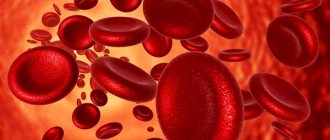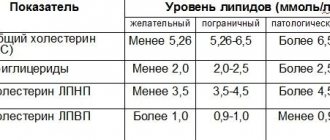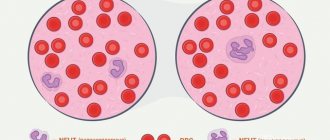Our body is an amazing thing. It is capable of producing all the substances necessary for life, coping with many viruses and bacteria, and finally providing us with a normal life. Human blood consists of formed elements and plasma. Leukocytes are one of these formed elements along with red blood cells and platelets.
What are leukocytes, their role, types
Leukocytes or, as they are also called, “white blood” perform the protective function of the body, destroying waste, toxins, viruses, bacteria and foreign bodies. They are a kind of line of defense that not only prevents the infection from spreading, but also destroys it.
White blood cells are produced in the bone marrow. Passing through a series of intermediate stages of development, mature cells that are capable of fighting infection enter the blood. However, their lifespan is quite short (varies from 4 to 20 days), so updating occurs regularly. A sharp increase in the production of leukocytes occurs in response to any tissue damage or the occurrence of harmful agents in order to provide a timely inflammatory response, the purpose of which is to isolate the damage, destroy the pathogen and restore tissue.

Cells of the leukocyte series are divided into 5 types, each of which has individual characteristics and functions:
- Basophils. This is the smallest group of leukocytes, which not only helps other cells detect foreign agents, but also prevents their spread in the body, neutralizes toxins and poisons and suppresses allergens;
- Eosinophils. They are the main effector cells in infectious, parasitic, allergic and oncological diseases. They are the ones who release mediators that are toxic to tissues and support inflammation;
- Monocytes. This is the largest type of leukocyte, the main function of which is phagocytosis, in other words, absorption, including quite large foreign particles;
- Lymphocytes. They, perhaps, perform one of the most important protective functions - they are responsible for immunity. They are the ones who produce antibodies that prevent recurrence of the disease. They make up from 25 to 40% of the total mass of leukocytes in the blood;
- Neutrophils. These are unique universal fighters who are able to leave the bloodstream and rush towards infection, actively promoting inflammation. This is the largest group of leukocytes that have the ability to absorb and destroy foreign particles.
White blood cell norm and age
To determine the number of leukocytes, a man must donate blood for a general analysis. The doctor will be interested in the WBC indicator (an abbreviation for “white blood cells”, which translates as “white blood cells”). The designations s/i and p/i, which appear in the analysis results, indicate their varieties—segmented and rod. The total level of leukocytes is measured in billions/l or in a numerical indicator that is multiplied by 109. At the age of 18-25 years, when a man’s body is already formed and is at its strongest, the normal level of leukocytes is considered to be 4-11×109. Since representatives of the stronger sex at 26-35 years old are subject to high psycho-emotional stress caused by problems at work and personal life, the normal level of white blood cells for them can be considered 3.5-8.5 × 109. Upon reaching the age limit of 36-45 years, male hormones reduce their activity, so the normal indicator for a healthy person is 3-8 × 109. In men over 46 years of age, the number of hormones decreases, so for them leukocytes of 2.9-7 × 109 are normal. For representatives of the stronger sex at a respectable age - over 60 years old - the leukocyte level is 2.8-8.5 × 109.
Indications for prescribing a leukocyte test
Since leukocyte analysis is carried out as part of a general blood test, every person who monitors their health undergoes it on a regular basis. These people also include pregnant women: in the absence of any signs of disease, they undergo this study regularly so that diseases and abnormalities in the development of pregnancy can be identified in advance.
In addition to medical examination, the analysis is taken during hospitalization and before surgery in order to conduct a basic examination and obtain information about the general condition of the body. As part of the diagnosis, a general analysis is prescribed if inflammatory processes in the body, parasitic infestations, infectious diseases and allergic reactions are suspected. Certain changes in the leukocyte composition may indicate oncology and serve as a reason for a more in-depth study.
This analysis is also used to assess the quality of treatment; the composition of the blood determines the effectiveness of the current drug therapy: perhaps the chosen plan does not help and needs to be adjusted.
The main factors for reducing hemoglobin
Hemoglobin levels decrease during pregnancy due to an increase in the total volume of circulating blood.
Pathological changes may indicate anemia:
- with large blood loss;
- chronic bleeding in small volumes (hemorrhoidal, uterine, etc.);
- with nutritional deficiency (iron-B12-folic deficiency);
- when transfusing large amounts of fluids and/or blood plasma;
- with massive destruction (hemolysis) of red blood cells;
- for various chronic diseases;
- with inhibition of the hematopoietic function of the bone marrow.
Any deviations from the norm require consultation with a therapist. If there are significant changes in hemoglobin levels, the patient is referred to a hematologist.
Be sure to regularly take a general blood test and undergo preventive examinations. The earlier the disease is detected, the more gentle and timely the treatment will be.
Preparing for analysis
The number of leukocytes in the blood depends on many factors, and the most important of them is age. Children have many more immune cells than adults. The time of day, diet and medications taken also affect. The situation is different in the case of gender - in men and women the leukocyte composition of the blood is approximately the same. The distribution norms for groups of leukocytes in a healthy person look like this:
- Basophils, as the smallest group, make up only 0.5 - 1% of the total number of leukocytes in one microliter of blood;
- Eosinophils occupy a slightly larger portion - 2.5%;
- Monocytes make up 5%;
- Lymphocytes belong to one of the most numerous groups and make up approximately 35% of the total number of leukocytes;
- Neutrophils are the most numerous group, accounting for 55%.
Leukocyte analysis is included in the general blood test, where leukocyte indicators reflect their total number. As already mentioned, age is very important when conducting analysis. The following standards exist for children:
- Newborn (1 - 3 days) - from 7 to 32 × 109 units per liter (U/l)
- Age up to 12 months - from 6 to 17.5 × 109 U/l
- Age from 1 to 2 years - from 6 to 17 × 109 U/l
- Age from 6 to 16 years - from 4.5 to 13.5 × 109 U/l
In adult men, the norm ranges from 4.2 to 9 × 109 U/l, and in adult women - from 3.98 to 10.4 × 109 U/l. In the elderly, the number of leukocytes decreases sharply, and for men the norm is from 3.9 to 8.5 × 109 U/l, and for women - from 3.7 to 9 × 109 U/l.
Glucose standards
| Category | Meaning | Unit measurements |
| Peripheral blood in adults | 3,3-5,5 | mmol/l |
| Venous blood in adults | 3,7-6,1 | mmol/l |
| Children under one year old | 2,8-4,4 | mmol/l |
| Children under one year of age (venous blood) | 3,3-5,0 | mmol/l |
| Children from 5 years old | 3,3-5,5 | mmol/l |
Blood sugar levels in adults should be in the range of 3.3 – 5.5 mmol/l. An increase in this value to 5.9 – 6.9 indicates a prediabetic state. If the glucose level is above critical levels, diabetes mellitus is diagnosed. With such values, consultation with an endocrinologist and specific tests are required.
Complete blood count for leukocytes
Clinical analysis of leukocytes, which is also called general, gives a detailed description of the qualitative and quantitative composition of blood, namely: characteristics of red blood cells and their indicators, characteristics of the number of leukocytes and the percentage of their groups and characteristics of platelets.
During a clinical blood test, special attention is paid to leukocytes, since the body’s ability to resist infections and various diseases depends on them. During the study, a leukocyte formula is compiled, that is, the number of leukocytes of all groups is given as a percentage: basophils, eosinophils, monocytes, lymphocytes and neutrophils.
It is noteworthy that an increased number of leukocytes indicates the presence of a disease, but it is not possible to make a specific diagnosis based only on this indicator. The data is analyzed only in conjunction with the results of the study of red blood cells and platelets (special attention is paid to red blood cells), only in this case will it be possible to either make an accurate diagnosis or plan further examination and treatment. Moreover, often the most accurate results can be obtained only by analyzing the dynamics of blood parameters, that is, by taking a general analysis several times.
Place of formation of leukocytes
The place of formation is the main hematopoietic stem cell of the bone marrow (pluripotent), during the disease it is capable of providing hematopoiesis independently. Precursor cells (the same as stem cells) are the next stage of formation. Unipotent cells (hematopoietic germs) become morphologically recognizable and mature into mature leukocytes, which are visible in the peripheral blood.

Their life expectancy, depending on the species, ranges from several hours to several months, is regulated by the leukocyte formula (by taking a general blood test from a finger prick) in clinical laboratories of medical institutions and is deciphered by a doctor. The destruction of white blood cells is called leukolysis.
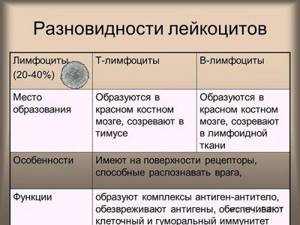
Video - Leukocytes
Interpretation of test results (increased leukocytes)
When the amount of white blood cells in the blood is higher than normal, this condition is called leukocytosis. Before making a diagnosis, it is important to initially exclude physiological leukocytosis, which, as a result of a slight increase in indicators, indicates that in the near future the person has experienced physical activity, stress, or simply ate (while eating, the body prepares in advance to protect itself from possible poisoning, increasing the number of leukocytes in the blood ). In this case, white blood cells increase evenly and for a short period of time.
The situation is different if the number from a particular group is increased. For example, if the count is in the thousands of neutrophils, this means that there is an inflammatory process in the body, or it indicates the presence of infection or tissue damage. When the result is already millions higher than normal, this can signal such dangerous diseases as oncology, tuberculosis, severe intoxication or serious injury.
By the number of eosinophils, one can determine the presence of an allergic reaction, which is manifested by a significant increase in the number of these cells in relation to other groups of leukocytes. The same reaction manifests itself into intolerance to certain medications.
An increase in basophils is often observed in pregnant women; this is the norm, but in the absence of pregnancy, this indicator signals possible problems with the intestines, kidneys, and spleen.
Lymphocytes are elevated if the body is suffering from a serious viral infection (for example, tuberculosis), and monocytic leukocytosis indicates that either a person who has had an infectious disease is now in the process of recovery, or it signals the presence of certain types of tumors.
Lack of white blood cells
Leukopenia in an adult is a condition when the number of leukocytes is below 4*109/l. This may be caused by malignant diseases, exposure to radiation, vitamin deficiencies or problems with hematopoietic function.
Leukopenia leads to the rapid development of various infections and a decrease in the body's resistance. A person feels chills, body temperature rises, loss of strength and exhaustion appear. The body tries to compensate for the lack of defense cells, resulting in an enlarged spleen. This condition is very dangerous and requires identification of the cause and treatment.
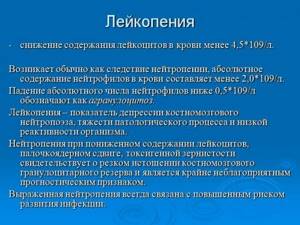
Chronic fatigue or other conditions that have been bothering you for a long time cannot be ignored. They often occur due to a decrease in the body's defenses.
Leukocytes in the blood are low
If leukocytes are elevated, it means there is an inflammatory process in the body, or a fight against infection, but the body fights on its own and often copes with the task, but what do low leukocytes signal? About a decrease in a person’s immunity, about a deterioration in the body’s ability to resist various diseases.
A reduced level of white blood cells indicates problems in the hematopoietic system, namely in the bone marrow, which produces blood cells. Chemotherapy for cancer, as well as taking interferon-based drugs, can cause a decrease in the number of indicators. but lower results do not always indicate the presence of a serious disease. Sometimes the reason can be simple - poor nutrition and a significant lack of certain vitamins: B vitamins, copper, iron and folic acid.
Severely low white blood cells can be a sign of a disease such as AIDS. This deviation should serve as a reason for conducting a more in-depth analysis of the health status.
Consequences of deviation of neutrophils from the norm
A change in the level of neutrophils in the blood is a signal from the body about the presence of inflammatory diseases, injuries or poisoning. Therefore, it is necessary to accurately determine the cause of the increase or decrease in neutrophils in order to begin treatment in time or eliminate the provoking factor. If this is not done on time, the consequences can be severe (even death). The greatest danger among possible causes is infectious diseases of a bacterial nature, as well as processes of local suppuration and necrotization (death) of tissue.
Examination at MedArt
If you want to get a 100% reliable result of a general (clinical) blood test, you will always be welcome at the MedArt diagnostic center. Our specialists are highly qualified and fully competent in the work entrusted to them. High-precision modern medical equipment, high-quality reagents, necessary consumables - we guarantee each of our clients service at the highest level.
With us, you can take a general blood test in a calm and comfortable environment, without distorting the results of your tests due to stress and emotional tension obtained in a long line. You can get accurate and reliable results in just one business day.


